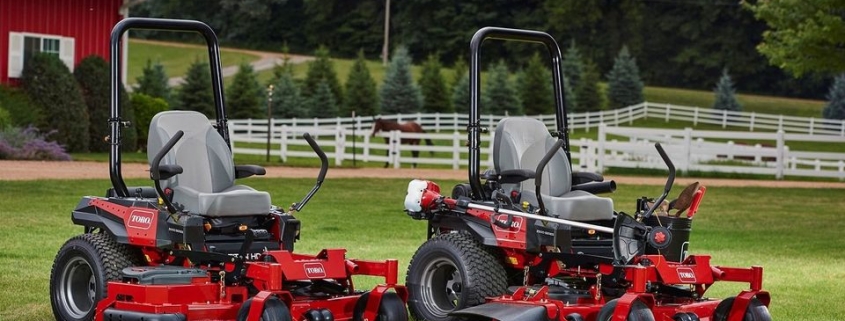Winterizing Your Lawn Mower
When you buy a lawn mower, you’re buying a machine that you expect to be mowing your yard for the next seven to ten years. We understand the value of properly maintaining your machine so that it will continue to be reliable for you year after year. When the fall rolls around, follow these tips on winterizing your mower to ensure your mower will be ready to go when you are in the Spring.
Gasoline
Gas can begin to degrade in as little as 30 days which when left in your mower can cause gumming that will clog up your carburetor and can also cause misfires in the engine. The result of this ends in costly repairs to clean the carburetor or possibly even a carburetor replacement ($300), none of which is covered by any manufacturer’s warranty policy. A carburetor is the valve that provides fuel to the engine, so when the valve is junked up and doesn’t operate properly, your engine will not perform as it should. The good news is that there are a couple of ways to prevent this from happening and keep your mower’s fuel system fresh.
1. All-Season Canned Fuel (RECOMMENDED): Simply empty all of the gas out of your tanks by running the mower out of gas. After it runs out, use All-Season Canned Fuel for 4-Cycle Engines to cycle through the engine. This engineered gasoline has a shelf life of three years and doesn’t contain any ethanol, which is one of the top reasons for fuel corrosion. With this high octane fuel sitting in your fuel system, you will have no issues hitting the ground running in the spring.
2. Fuel Treatment: Add fuel treatment, also know as fuel stabilizer, to the existing gas in the mower. It will help to protect your engine from gum, rust and corrosion that standard gasoline can cause. Stabilizer can preserve fuel for up to six months, but it can be affected by the climate and environment it sits in. So be cautious when solely depending on fuel stabilizers to treat your fuel over winter.
Battery
Some might say that lawn mower batteries are garbage in general and that you should expect to get a new one every year. That might be true for some of the batteries on the market, but there are several things that you can do to stretch the life of your battery.
The first thing is the most obvious and is the most effective, but most people just don’t make it a priority and that being going and starting your mower a couple times a month and letting it run for a while. This will cycle gas and oil through your engine, will pump hydraulic oil through the wheel motors and will allow the battery to charge. Overall this is the absolute best practice, but if we’re being honest, going outside to the shed or barn to start your mower in the snow doesn’t seem to fall at the top of the priority list. So here are a few alternatives:
1. Trickle Charger (RECOMMENDED): Keeping your battery active and charged is the most important thing in maintaining battery life. If you don’t want to unhook your battery from the mower, simply get a trickle charge and hook it up to your battery. All you will need is an outlet next to your mower. You can get any type of trickle charger, but here’s a link to one on Amazon.
2. Storing At Room Temperature: Batteries have a low freezing tolerance meaning when the acid inside of the battery freezes, it can cause major damage to the cells inside. When this happens, you will get cells that go bad or your cold cranking amps (CCA) will permanently decrease which causes the battery to not perform dependably. So if you will unhook your battery from the mower and store in a garage or a place that will not freeze, you will extend the life of your battery.
Note: Do not store on directly on concrete floors as the concrete will pull the moisture out of your battery causing permanent damage.
Clean & Store
Cleaning your mower will allow it to run more efficiently and cut better while also preserving the paint and mechanical parts. When grass, dirt, leaves, etc. sit on your mower for months as they decompose, it can cause the paint and metal to crack or rust. By cleaning your mower of this on a regular basis and especially before winter, you will preserve the machine as a whole. But when I say clean, I mean a little more than just giving it a good scrub for looks and that being found under the deck.
When you cut grass, some of it collects under your deck against the side walls and will stick. The amount that collects is much more when you are mowing wet grass. Many manufacturers have deck washout ports as standard features on their mowers so that you can keep this collection from becoming a problem. In general, they work great as long as you use them every time that you mow wet grass, but once that wet grass collects, it dries like concrete. This can cause your deck to not get the proper flow of air to cut correctly, which will leave your yard looking uneven and uncut in some areas. It’s a good idea to check under your deck before storing it for winter for any grass buildups. You can remove the grass or dirt with something as simple as a paint scraper. This will make sure your mower has the best cut possible next spring.
When it comes to storing your mower, under cover is the best to protect your machine from the sun, rain, wind and snow. Repainting your mower can be costly and time consuming while a new seat is an automatic $500. If under a roof isn’t a possibility for you, consider an outdoor mower cover. For $50-$60 you can keep your mower from fading, cracking or rusting.
Summary
If you take a couple hours to winterize your mower, you’ll be extending your mower’s life by years. Not only will the machine last longer, it will operate at peak performance and you’ll be a lot less frustrated along the way. Do yourself a favor and save yourself some money by taking a few hours to follow the steps above and winterize your lawn mower. Happy mowing!
 6147 Morehead Road Flemingsburg, KY 41041
6147 Morehead Road Flemingsburg, KY 41041


